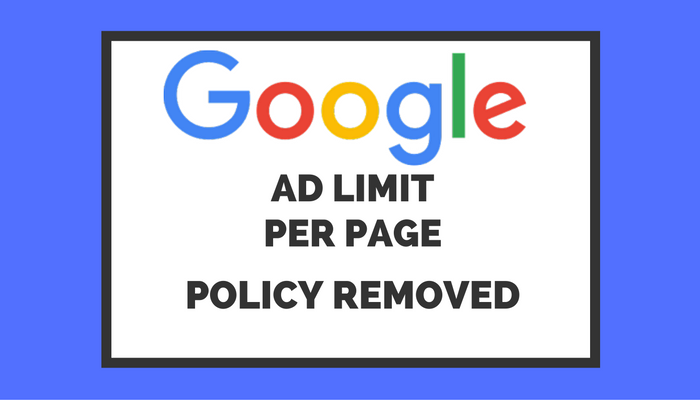Google recently refreshed its AdSense ad limit policy, removing the restriction it once had on the amount of ads publishers can place on one page.
Old Policy vs. New Policy
Using the WayBack Machine, you can see that the policy once read as follows:
“Currently, on each page AdSense publishers may place:
– Up to three AdSense for content units
– Up to three link units
– Up to two search boxesPublishers may not place more than one “large” ad unit per page. We define a “large” ad unit as any unit similar in size to our 300×600 format. For example, this would include our 300×1050 and 970×250 formats, our 750×200 and 580×400 regional formats, and any other custom sized ad with comparable dimensions.”
Now, you can see in Google’s current ad placement policies that the ‘ad limit per page’ section has been removed. It has been replaced with a section titled ‘valuable inventory’, which cautions site owners not to let the amount of ads on a page exceed the amount of actual content. Doing so may result in Google limiting or disabling ads served on the page until appropriate changes are made.
I spoke with a Google representative this afternoon who confirmed the ad limit has been removed.
Reasons Behind the Removal of Google’s AdSense Ad Limit
Google’s previous ad limit policy was in effect for many years — in fact, the company has not updated it since the rise of mobile.
Improving Web Content
The primary reason behind this change is to create a better balance between quality content and advertising. Rather than looking at this change as a cap that has been removed, it should be looked at as a way to improve the overall quality of content on the web.
One of the ways many publishers have been getting around the ad limit is to break content down into multiple pages using slideshows. Removing the limit on the amount of ads that can be placed on one page will hopefully lead to less slideshow-based content, and more high quality content.
Encouraging Publishers to Test New Ad Units
To coincide with the rise of mobile, Google introduced new mobile-friendly ad units. However, publishers are hesitant to test the new ad units because they don’t want to give up any ad units that are currently in place.
If publishers remove one of the ad units they’re currently using it could potentially lead to a loss in revenue. Realizing this, Google made the decision to rethink the ad limit policy in hopes that more publishers will begin using the new mobile-friendly ads.
Keeping Advertisers Happy
Companies that are paying to advertise via mobile-friendly ad units are not receiving a maximum return on investment if publishers are not utilizing the ads. Publishers are a critical component of advertising; if publishers don’t display the ads then companies will be less likely to pay for advertising.
Google sees this change as more of a partnership with its publishers, allowing them to further monetize their content while keeping advertisers happy at the same time.
Will Publishers Go Overboard With Ads?
Now that there is no defined limit on the amount of ads that can be placed on a single page, is there a concern that publishers may start to abuse their advertising privileges?
It’s still in a publisher’s best interest not to go overboard with ads, because it would degrade the user experience. If visitors are inundated with too many ads it could lead to them abandoning the web page, which would in turn affect a publisher’s ability to monetize.
Although there is no longer an exact limit on the amount of ads that can be used on a page, there still has to be a suitable balance between ads and original content. Using an excessive amount of ads can still lead to a violation of Google’s ad implementation policies, which will result in Google either limiting or disabling a publisher’s ads.





